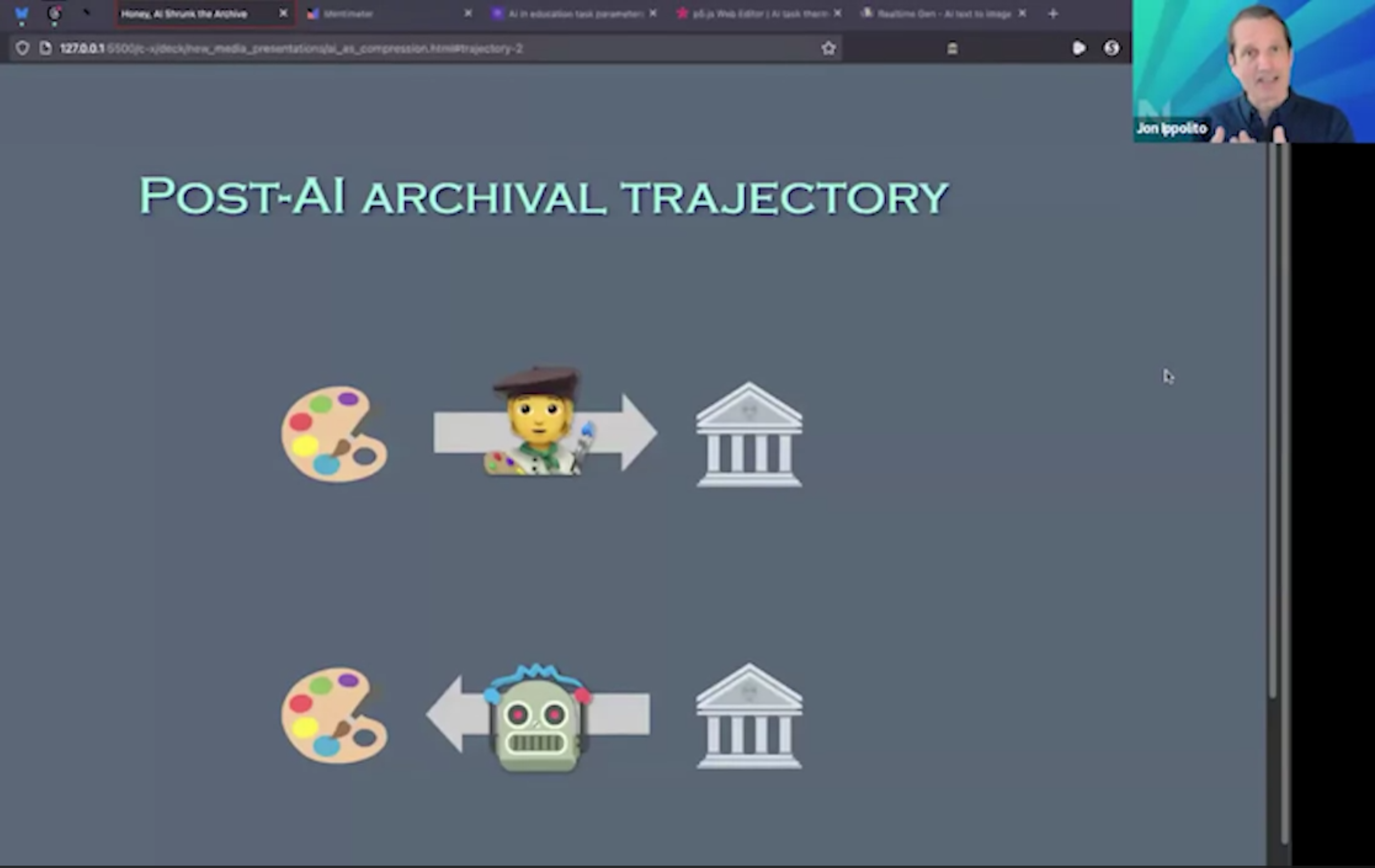Honey, AI Shrunk the Archive
IEEE/UMaine AI teleconference
Excerpt playing: (choose from the outline below)
Introduction
00:00 Ali Abedi introduces the webinar
01:09 The promise and threat of AI-driven archives
Audience survey on appropriate uses of AI
Ethical concerns about AI in general
AI's impact on the archive
05:33 From shelves to databases to AI models
07:00 "AI is an archive in reverse"—Eryk Salvaggio
Animistic AI metaphors
08:05 Why animate metaphors are misleading.
The problem with both pro-AI (superbeing) and anti-AI (stochastic parrots)
Heterogeneous versus homogenous complexity
Training a model versus training a baby
Mechanistic AI analogs
14:28 AI as compression algorithm
17:49 gzip beats BERT as a text classifier!
Large language models have thermodynamic properties that help us tune them
20:53 Adjusting temperature to tune AI output
Audience questions
25:54 Question: can original data be retrieved accurately from AI compression?
28:46 Question: how appropriate is the term "hallucination" for false outputs?
32:15 Question: why don't models admit when they don't know?
33:20 Question: is confabulation a better term than hallucination?
33:45 Ali Abedi: generative AI is the latest stage in compression
From analog sensory data to digital sampling to sophisticated compression
37:37 Question: is there a fair trade AI comparable to fair trade coffee?
Consequences of mechanistic analogy
38:04 Adjusting energy to tune AI output
39:55 Surprises of probability: the importance of density and temperature
The chance of your next lungful containing a molecule of Julius Caesar's dying breath is 98%!
45:09 Mistuned AI: insufficient density (obituary spam)
46:20 Mistuned AI: insufficient temperature (AI missing tumors)
47:00 Mistuned AI: too much temperature (bogus court cases)
47:20 Audience survey on density and variability for four tasks
Using ChatGPT to generate a chart to visualize audience results
53:10 Perceived best density and temperature for four tasks
- Commenting on an essay
- Grading an essay
- Summarizing a meeting
- Representing you at a meeting
55:55 Using thermodynamics to predict which tasks will succeed or fail
What the available density and temperature tell us
Warping the archival trajectory
56:44 AI improving access to collections
Using AI to find items in the Rijksmuseum collection
59:01 AI replacing collections
Leonardo.ai's realtime image generation
Will users post a real photo of the Colosseum when they can more easily generate one?
62:12 Replacing the entire web with Websim.ai
"Capy-bara-dise Getaways"
65:31 Replacing actual artists' websites
66:11 From the archive in reverse to the archival loop
New derivatives become the next training data, gradually losing fidelity due to compression
68:10 Conclusion: why mechanistic analogs lead to better insights than animate metaphors
The compression analogy helps explain what is good and bad about large language models
The thermodynamic analogy helps us tune models to specific uses
This teleconference is a project of the University of Maine's Digital Curation program. For more information, contact ude.eniam@otiloppij.
Timecodes are in minutes: seconds
Whether wielded by AI critics or champions, animistic metaphors like stochastic parrots and godlike oracles obscure important dynamics of large language models. Drawing on insights from the science of thermodynamics and software compression, this talk by New Media professor Jon Ippolito explores what mechanistic comparisons reveal about generative AI that are concealed by analogies to living beings.

Just as a JPEG discards fine details to shrink an image, large language models smooth over anomalies and erase outliers. Understanding how compression works can help us apply AI effectively while avoiding a future where knowledge is not stored but continually rewritten, and where the archive itself risks being compressed out of existence.
This talk from 3 April 2025 was moderated by Ali Abedi of UMaine AI and hosted by IEEE in conjunction with UMaine's New Media and Digital Curation programs, which regularly organize teleconferences about topics on the cutting edge of digital culture. For a text version of this talk, see "Honey, AI Shrunk the Archive: AI as Compression Algorithm," forthcoming from Bloomsbury Press.
Watch the entire video or choose an excerpt from the menu on this page.
Or view more teleconferences from the Digital Curation program.
